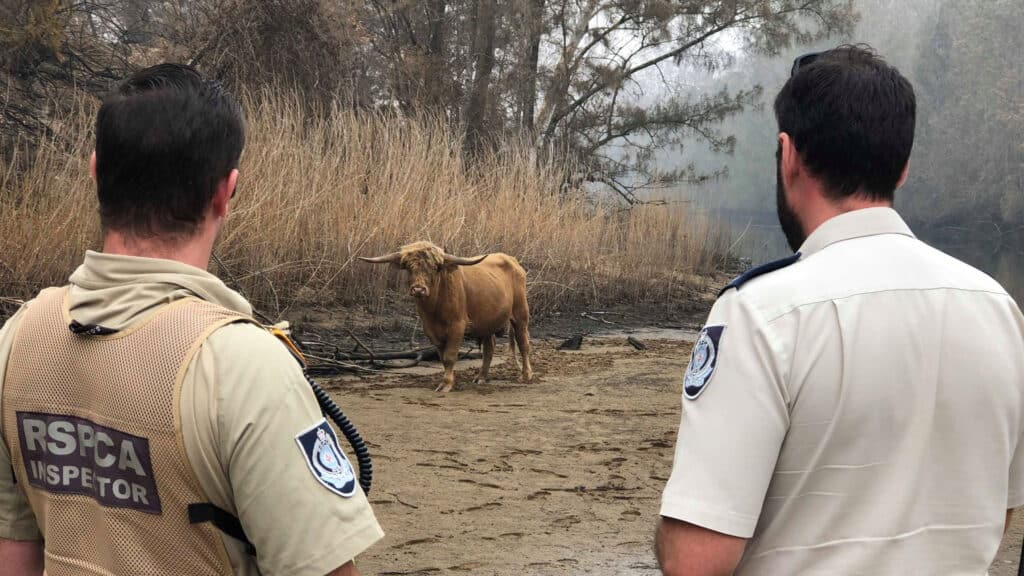Home > Information and Advice > Caring for Animals > Pet Hazards
As pet owners, it is our responsibility to protect our animal companions from both potentially fatal items and stressful situations. Thankfully, we know it takes a village to protect our pets, which is why we’re committed to empowering carers to keep their animals happy and safe.
Fireworks, extreme weather, and even seasonal festivities can each have a harmful effect on the welfare of our pets. Household items such as plants, human medicine, and certain foods can also be dangerous when ingested, which is why it’s important to learn to avoid exposing your pet to harm.

In warmer, drier conditions, bushfires can quickly get out of control and pose a serious risk to your pets.
Whether you’re preparing an evacuation kit or putting preventative measures in place, including your animals in your plan is essential for their safety.
With an emergency plan in place, you can greatly increase the likelihood of keeping your animal companions safe.
Snakes become more active during the warmer summer months.
Pet owners should be careful to protect their furry friends from snakes, in addition to learning about the warning signs of a snake bite affecting your pet.
Although it’s impossible to prevent the droughts that Australia regularly endures, RSPCA NSW aims to assist drought-affected communities – and protect the human and animal bond – whenever and wherever we can.
Every animal guardian should know that some plants are poisonous to pets. An animal ingesting toxic plants may face serious illness, health complications, and (in some cases) even death.
As a result, it’s important to understand the risks associated with certain plants before bringing them into your home where they may be accessed by your pets.
Seasonal celebrations, such as Christmas, can be a time of great cheer for us humans. But, for pets, festive events can be noisy, unpredictable, and rife with hazardous items, decoration, and food.
Before you introduce visitors, new decorations, and harmful foods into your home, it’s important to learn to keep your animals safe during parties and festive events.
Animals need constant access to water and shelter from the heat or sun, particularly during hot days and throughout the summer months.
At RSPCA NSW, we love empowering people to support their pets, which is why we’re committed to helping you keep your companion cool, hydrated, and safe.
Our pet’s sense of hearing is usually far better than our own, which is why so many animals are fearful of disturbances and storms.
Fireworks, for example, typically explode at a staggering 145-150 decibels, meaning they can be frightening and loud for our animal companions.
Providing your pet with your company and a comfortable living space can be a vital step in ensuring your pet feels safe at home.
In addition to directly supporting our communities during bushfires, droughts, and floods, we educate pet owners about emergency preparedness to proactively minimise risk and safeguard animals’ lives.



RSPCA NSW rehomes a range of different animals, from dogs, cats, and birds to horses, rabbits, and sheep! We believe that all creatures, great and small, can bring joy to our families and homes. Begin your adoption journey today and make an adorable lifelong friend!
By providing temporary homes for our animals, we can ensure they get the care they need until they are ready to be adopted. Join our network of foster carers for an incredibly rewarding experience; with your help, we can change the lives of some of the state’s most vulnerable animals.
We rely on our generous supporters to continue assisting the thousands of animals turning to RSPCA NSW for help. No matter how small your contribution, every gift makes a lifesaving difference for animals in need.
By raising funds and lending a hand to communities and their pets, our volunteers play a pivotal role in our work throughout NSW. If you have a genuine concern for animals and enjoy meeting like-minded people, consider becoming an RSPCA NSW volunteer today!
We promise to uphold the highest ethical standards. Your personal information has never been, and never will be sold or traded to other charities. This is our promise to you.



We acknowledge the Traditional Owners of the lands on which we live and work. We recognise and respect the enduring relationship they have with their lands and waterways, and particularly acknowledge the vital role animals have played in Indigenous life, stories and culture for tens of thousands of years.
The RSPCA is an independent, community-based charity providing animal care and protection services across the country.
This site is protected by reCAPTCHA and the Google Privacy Policy and Terms of Service apply.
The RSPCA is an independent, community-based charity providing animal care and protection services across the country.


This site is protected by reCAPTCHA and the Google Privacy Policy and Terms of Service apply.